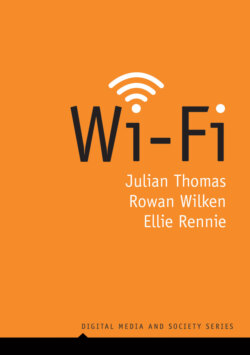Читать книгу Wi-Fi - Ellie Rennie - Страница 7
1 Why Wi-Fi Matters
ОглавлениеWhen catastrophe strikes, we see communication in new ways. January 2020 was high summer in the southern hemisphere. Holiday makers, together with their smartphones, flocked to the beaches and camping grounds of the Australian coast. But, after years of drought and record high temperatures linked to global warming, the forests were on fire. Hot days, dry air, parched bush, and gusty winds created the conditions for huge, fast-moving fires. Ancient rainforests which had never experienced fire were lost. The fires isolated and burned through small townships. They left thousands of people homeless and stranded. With roads blocked by fire and fallen trees, people were trapped in small coastal communities for many days. There they managed as best they could, sheltering on beaches, making do in tents, sheds, and caravans.
Months later, when eventually the fires were controlled or extinguished by rain, the damage to people, wildlife, and the environment was immense: 186,000 square kilometres were burnt and 5,900 buildings were lost. Thirty-four people died, and an estimated 3 billion animals were killed or displaced. As well as burning bush and buildings, the fire ravaged the essential infrastructure people rely on: power lines, water supplies, roads, and communications. The fire destroyed cellular phone towers and landlines. Fixed and mobile broadband services failed, leaving homes, visitors, and businesses without internet. Destruction led to disconnection. Electronic payment systems and cash machines could not be used; health records could not be accessed.
A crisis of this kind reveals not only the central importance of modern communication networks for our safety, security, and economic and social connections, but also their fragility. It uncovers both remarkable adaptive capabilities and fundamental weaknesses. The gaps appear between our settled expectations of communication and the unpredictability of events. In the immediate aftermath of the fires, reconnection to communication was a critical priority. Stop-gap solutions depended on what was damaged and what resources could be readily used. If cell-phone towers or exchanges were undamaged but power supplies were destroyed, back-up power could be provided, sometimes with the help of the fire services. Where cellular networks were available, telecommunications companies could increase data allowances or make other concessions to users. If public phone booths were functioning, they could be reconfigured as public Wi-Fi base stations. Wireless communication networks could stand in for burnt-out fixed lines. Australia’s national broadband network offered access to its satellite internet service through trucks which combined a mobile satellite connection, Wi-Fi base stations, laptops, and charging points for mobile devices.
As we finished this book, some months after the fires, a number of these mobile connection units were still in place in small towns across the fireground, parked in public spaces, reserves, and camping grounds. They continued to provide essential communications while the arduous and protracted business of recovery and rebuilding proceeded.
Events also moved on: by March 2020, and only barely after the worst of the fires in Australia, a new catastrophe engulfed us, of a kind few expected. In the space of just a year, the Covid-19 pandemic has taken over 2 million lives. In order to control the spread of the virus, governments around the world froze their economies. They closed borders, schools, universities, and businesses. Millions of people lost their jobs. Those who could work from home were required or impelled to do so. For those families that were connected, parents began supervising their children’s online lessons, juggling school with the imperatives of work. For households without internet, the difficulties were multiplied. According to UNICEF, the United Nations International Children’s Emergency Fund (2020), around a third of the world’s school children were without access to remote learning, making it impossible for them to continue their education.
Figure 1.1 A mobile Wi-Fi hotspot, provided by the Australian internet network operator NBN during the 2019/20 bushfire season, at an evacuation centre, Bateman’s Bay, New South Wales. The truck offers free Wi-Fi and device charging. It connects to the internet through NBN’s satellite service. Source: NBN Co. Ltd.
For us, the authors of this book, and for many others, the pandemic abruptly suspended mobile working lives, the everyday cycles of work at the office and periodic travel for meetings, research, and conferences. Working at home was always a necessary part of that cycle; now, for those fortunate enough to keep their jobs or find new ones, working space and domestic space entirely converged. New physical and functional segmentations of the home were required to make work and study spaces for everyone, from the kitchen table to the corners of rooms and corridors intended for other things. Home Wi-Fi assumed a critical role, as we rapidly came to rely on it for maintaining the simultaneous multiplicity of education, family, and social connections, as well as the everyday tasks of teaching, research, and professional communication.
The pandemic created a new ‘landscape of risk’ (Robinson et al., 2020; Zinn and McDonald, 2018). For those connected people able to work and shelter at home, Wi-Fi made possible a domestic bubble, a safer space offering shelter while the pandemic progressed. These people were the best placed to sustain their health and welfare during the pandemic. They could carry on without greatly exposing themselves to the risk of infection. Outside the bubble, the experiences of those without affordable communications and the skills to use them were very different. Just as the role of private Wi-Fi suddenly expanded in the home, so access to public Wi-Fi receded just as quickly. Libraries, schools, and universities closed. Cafés where students once lingered over their laptops were reduced to serving coffee to go. Many people avoided public transport if possible. Low-income families with school age children, homeless and vulnerable people, were all suddenly more socially and economically isolated by virtue of their digital disconnection. Soon after cities began to shut down, reports appeared of people working from their cars in library parking lots, attempting to use the Wi-Fi from outside.
